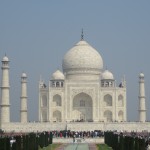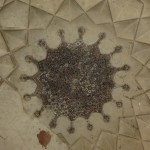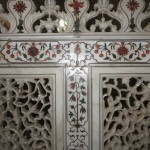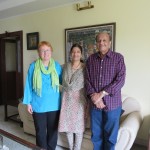Monument to Love
- By Katharine
- 4 March, 2014
- No Comments
We arrived in Agra at night, craning our necks for a possible view of the Taj Mahal. We pointed and gawked when, over a high wall, we spotted a large, white dome — but as we got closer, we discovered it was the top half of a giant hot-air balloon from which other, more well-heeled tourists, were viewing the Taj at night.
We went to dinner at a rooftop restaurant — again, not high enough to see the Taj Mahal — to celebrate Kate’s 31st birthday, buying her an astrological and palm reading from the resident fortune-teller. Kate is a massage therapist for Virgin Atlantic and came to India with her good friend Sally — an absolutely lovely and fun pair of young women whom I am trying to lure to New Hampshire and Cape Cod. After dinner, complete with excellent chocolate birthday cake, our tour leader, Ranobir Guha, set off two fireworks shows in the road outside our hotel. I’d never seen anything like it, although apparently they are common in England: You set out a box with about 35 compartments, light one fuse, and stand back as they shoot off one by one, exploding in colors and trails overhead. Lots of cinders fell on us, and one burned Rosanna’s cheek a bit.
Another day, another fort — this time, Amber Fort, on a promontory over the Yamuna River. We visited in the early morning fog, walking over a moat once filled with crocodiles AND alligators, according to our guide, then passing through the outer gate up a ramp that was grooved so that elephants, camels, and horses could gain traction on the otherwise slippery stone. The outer and inner gates were set at odd angles so invading armies couldn’t break down the massive wooden doors with charging elephants, who needed to get up speed on a straightaway. The space in-between also could be filled with tigers and other ferocious beasts when there was a need to guard against invaders, and lastly there were towers with openings for pouring down boiling oil — a horrible death, or at least very slippery as it ran down the ramp. Nonetheless, this major fort so close to Delhi was invaded and conquered quite often, especially during the Mughal era. Its present form is primarily the work of Akbar, but his grandson Shah Jahan, who built Old Delhi and its Red Fort, also made many improvements. The most impressive room was a whispering chamber, where the emperor could lie in one corner and whisper endearments to his wife in another. It had an unusual, faceted ceiling and curved walls. We tried it out by standing in one corner and talking to the person in the other — it worked better than a telephone!
Shah Jahan and his favorite wife, Mumtaz Mahal, had 14 children, eight of whom died young, according to our guide. Shah Jahan was left with two daughters and four sons. After Mumtaz Mahal died in childbirth, Shah Jahan was so distraught that he planned and built the Taj Mahal as a memorial to her, pouring the equivalent of billions of rupees into the magnificent white marble and inlay work. He wanted to build a second, black marble dome to match. But his third son, Aurangzeb, killed his three brothers and deposed his father, keeping Shah Jahan confined to a white marble palace near the top of the fort with a view of the Taj Mahal. One of Shah Jahan’s daughters remained unmarried and looked after her father until he died — supposedly just as the Taj was completed.
After a break for coffee and/or lemonade (the strawberry lemonade here is a little bit sweet and has fresh, crunchy basil seeds in it!) we finally arrived at the iconic monument to love. We entered the grounds through the East Gate with only our handbags — very thoroughly searched — our cameras, a small bottle of water, and white paper shoe covers. First you traverse an outer courtyard, and finally come through a beautiful red sandstone archway that perfectly frames the Taj Mahal, which sits at the other end of two shallow pools with many soft fountains, surrounded by lush lawns and spectacular flower beds. There was a fair amount of crowding and jockeying for position at key photo points, but otherwise the experience was surprisingly serene.
I’d been a bit afraid that seeing the real thing would prove anti-climactic after viewing so many photos of it. And yet when I first had a chance to stand aside and look at it in silence, tears sprang to my eyes. (Perhaps this was the effect of days of cumulative sleep deprivation and a generally sentimental nature.) We ambled alongside the fountains, stopping at a platform midway with marble benches, including “Diana’s Bench,” where first Jackie Kennedy and later Princess Diana had posed for photos with the Taj in the background. This platform yields the best, front-on views of the white marble structure, framed and balanced by two, smaller mahals of red sandstone and white marble, so competition for photo space was intense. Lots of young Indian men posed as if holding up the Taj Mahal by the spire on top.
Finally, as high-price ticket holders, we put paper coverings over our shoes and entered the center of the Taj Mahal, where a round screened structure surrounds two cenotaphs: a taller one for the king and a lower one for the queen. The crowding here was bad, with guards trying to move people along and the shorter among us trying to get to the one opening where we could actually see the cenotaphs for a moment. A private tour would have been nice! I did get one good look, and then — once out of the central chamber — was able to take my time admiring the carved marble screens, relief work, and inlay with semi-precious stones. The architectural details were incredible, both inside and out, and on the marble back “patio” behind the central building, we had a lovely view over the meandering Yamuna River, with its many sandbars, to fields of green crops. Upriver we could see the fort and the palace from which Shah Jahan watched the Taj Mahal’s progress.
After two hours and many more photos, we left for a very late lunch at yet another good restaurant. A few people went shopping again, but I went back to the hotel to rest a bit before our evening train back to Delhi — which was supposed to leave at 8:35, but didn’t depart until 10:10 p.m. We had “Meals on Wheels” — a surprisingly good packaged dinner of saag paneer, dalh, rice, bread, and yogurt — on the train, then snoozed. We arrived back at our Delhi hotel around 1 a.m., exchanged e-mails and said our good-byes. Then I snatched four hours of sleep before 5:30, when I got up for a 9 a.m. flight to Pune.
Now begins the more prosaic and “real” part of my trip — not the India of monuments to the past, but of striving for the future. A lovely young woman who works for a technology company and was taking a business trip to its office in Pune sat next to me on the plane. Nidhi arranged a prepaid taxi to my hotel and insisted I call her when I got here, just to make sure I was safe. My room is the quietest I’ve been in for the whole trip, near a hospital and right next door to the Osho Meditation Center in the Kuregaon Park area of Pune. Most of my fellow guests wear the maroon robes or tops and “pajama” pants that indicate they are meditating at the Osho center every day (this hotel is popular with Osho visitors, as it’s cheaper than the first-class resort run by Osho Intl.) My hotel room opens onto a porch a few steps above the front lawn, and also has an outdoor walkway with seats out back, where I can hear the music the Osho center broadcasts over loudspeakers. After lunch at the vegetarian Italian restaurant on the premises — including a fabulous, well-washed and disinfected salad, the first one I’ve felt safe eating since arriving in India — I took a good, long nap before venturing out by taxi to a meeting of the Maharashtra humanist and rationalist group, held in a study center over a bookstore.
My host, Deepak Girme, introduced me and explained a bit about what I was writing. Then the meeting proceeded for another hour or so in pure Maharashtri, the language of this state, which has a population of more than 100 million people. The group, which meets weekly to read and discuss one chapter by its founder, Dr. Dabholkar, included about 10 women and another 30 men: The topic for the evening was how to overcome the low status of women, and how superstition feeds into and prevents women’s liberation. I wished I could understand the whole discussion, but hope to learn more about what was said today, when Mr. Girme has invited me to his home for lunch and to meet his family. Still, there was never a dull moment — lots of story-telling, lively laughter, evocative gestures, and applause, with an occasional English phrase like “scientific temperament” scattered in. They had two questions for me: Do families in the U.S. keep having children until they produce a son? And do families pay for the education of sons, but not daughters? I’m afraid I made the U.S. sound better than it really is, but we are more advanced — at least on those two points. I answered the second question by telling them, “My brother is a doctor, my sister is a doctor, my other sister is a social worker, and I am a journalist. We all went to college, and our parents paid for all of us.” Afterwards I was able to talk a bit with a couple of people in English, and had my photo taken with some of the women. One was a student of social work who had just joined, and another woman teaches karate and judo and the use of the lathi, a fighting stick, to girls. She is also very into crafts and plans on making some puppets, so the group can make videos of puppet plays for children about the importance of exercise, education, and good health.
My taxi driver had waited for me for nearly a full two hours. This is cheaper than calling a taxi, then calling another when you are ready to leave someplace. I had a great night’s sleep and, after breakfast on my “porch,” I headed down the block to the Osho Meditation Center, hoping for a tour. The outdoor reception desk was manned by a guy wearing a sleeveless, full-length maroon robe. Originally from Boston, he now goes by the name Krishna. He once wrote questions for the TV shows “The Dating Game” and “The Newlyweds Game,” but came to Osho’s center here about 20 years ago and never left. He informed me that they stopped doing tours about five years ago, but tried to get me to stay at the resort, saying ruefully that bookings are down by 30 percent this year because of all the international news reports on a couple of gang rapes in India. I also spoke with another man about my age, Dan, from San Diego, and they sent me to the bookstore just off the main gate. Every book, CD, and DVD, was by Osho, so I walked around and then left. Shocked that I’d only spent 2 minutes, Krishna and Dan started joking around with me and I ended up talking to them for a good half-hour about why they’d come and what it was like inside. Dan was the more earnest one; Krishna thought I was meant to be here — and already somewhat enlightened, but he kept saying that I was going to get him into trouble because, while we were talking and laughing, he wasn’t paying enough attention to the people entering through the metal detector and running their bags through the screening system. So I put my hands together and said, “Laughter is a form of prayer,” and bowed to him.
Our laughter drew several people over, who wanted to know what was so funny, but I was relieved in a way not to be able to go inside — unless I wanted to pay $50 for a day meditation pass, which I had no intention of doing. Dan told me that this was his second stay at the resort, and that it has been a very intense experience both times: He has fallen in love and felt the bliss of his heart chakra opening to its fullest extent, but woke up this morning just feeling like he wanted to be taken by ambulance straight to the Mumbai airport and home to San Diego. By the time he spoke with me, he wasn’t feeling quite so desperate, but he said that as an American, used to figuring things out and being somewhat in control, he sometimes found the crazy atmosphere hard to take. Krishna has written a book about his experiences with Osho, whom he met before the guru passed on, which I later tried to buy at another “Osho Inspiration” bookstore he’d told me about. Alas, they were “Out of stock, Madam.”
I took an auto-rickshaw all the way across the city today to have lunch with the Girmes. Both speak English quite well, as they visit the United States once a year or so to visit their daughter and her family in Seattle. Another daughter lives in Perth, Australia. We had a very interesting conversation about how he became a rationalist and skeptic, and why Americans are so enamored of Indian spirituality. The lunch — which was spiced wonderfully, but not hot, in deference to my delicate palate — was marvelous: Marathi fried pomfret, prawns in a garlicky sauce, spinach and potatoes, homemade bread (chapatis), and a fish soup. This was followed by fig ice cream! Mrs. Girme presented me with some bangles that matched my shirt perfectly, as well as some lovely, hand-crafted tea light holders. I felt bad that I had no hostess gift to bring them. Deepak had already talked by phone with the Shankaracharya in Kolhapur and told him I hoped to speak with him. Turns out the Shankaracharya is coming to Pune tomorrow, just as I’m leaving here for Kolhapur, but he will be back on Friday and wants to show me his monastery. Several other members of Deepak’s group will also be awaiting me. Everyone has been so kind and hospitable, I’m overwhelmed.





 Copyright © 2025
Copyright © 2025
Leave a Reply